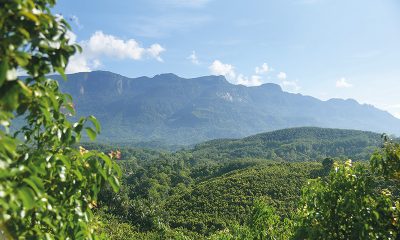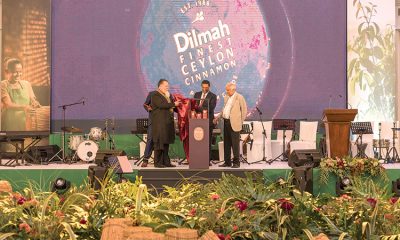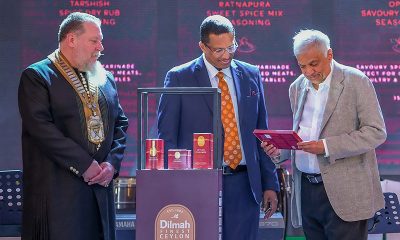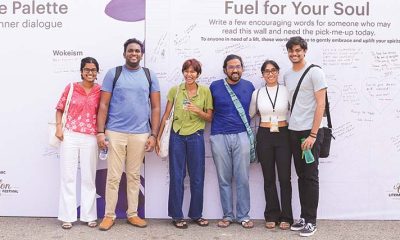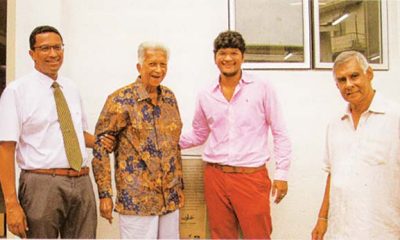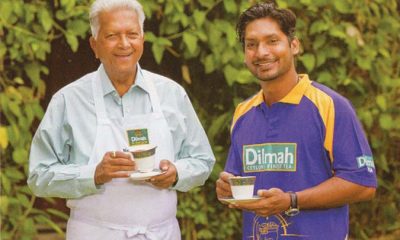Features
Lion logo loses clout as Ceylon Tea marketing symbol
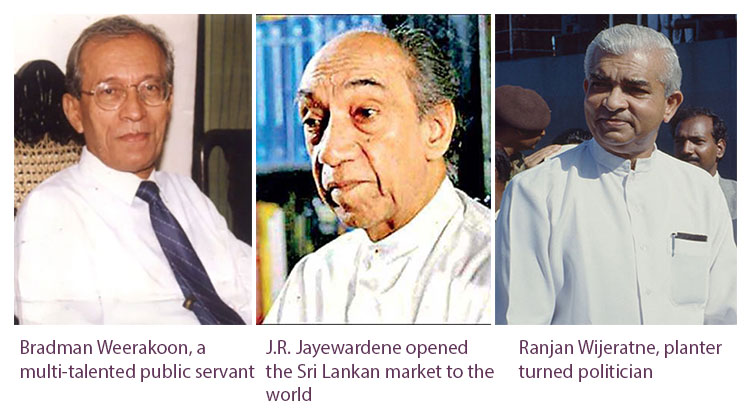
Very little pure Ceylon Tea in the packs sold
(Excerpted from the autobiography of Merrill J. Fernando)
The Lion symbol had been used to denote Ceylon Tea for a number of years until, in 1978, it was registered in the UK as a symbol belonging to the Sri Lanka Tea Board. It had also been registered in a dozen countries in Europe, as well as in Australia, South Africa, Pakistan, and in about 15 other countries in the Middle East.
Since the Lion symbol professed to represent quality Ceylon Tea, but without a quality benchmark being attached to the pack which carried the logo, the recommendation of the above committee was that a new symbol should be developed, for the use of the entire export sector, to denote packs containing 100% Ceylon Tea conforming to a specific quality standard. The committee also recommended the promotion of Ceylon Tea in particular geographical areas, such as the Middle East and Western Europe primarily and, secondarily, in the Philippines, Nigeria, and Japan.
Up to that time, as far as I am aware, the above was the most searching examination of Ceylon Tea export promotion carried, out in decades. Unarguably, it was the only evaluation which resulted in proposals giving primary consideration for the benefit of the local exporter.
Discouraging realities
The consumer soon loses interest in a product which does not live up to its projected quality image. As explained in detail above, the Lion logo lost its effectiveness as a promotional tool when the genuine, quality Pure Ceylon Tea packs were debased, by the gradual diminution of the Ceylon Tea content in the pack, and its replacement with cheaper, lower quality tea. My arguments on the matter were based on my firm conviction, that it is important to associate a generic symbol with a guarantee of good quality Ceylon Tea and not of any tea identified as Ceylon Tea. The Lion logo finally became meaningless, as it was available to any brand associated with the legend ‘Ceylon’ on the pack, however tenuous the link.
Another area in which the Secretariat failed was in the very necessary monitoring of rebates and other incentives, extended to exporters to develop their own brands, invest in plant and machinery, and to generate value-added exports, instead of persisting with the export of bulk tea. The concessions were meant to incentivise development and investment with the long-term benefit in view.
What actually happened was that, with very few exceptions, the majority of the exporters discounted these rebates to the benefit of the importers that they were serving, who, anyway, were already buying their tea at prices well below those obtained for finished tea products in their countries.
This highly-irregular strategy resulted in the development of a culture of cutthroat competition among exporters, fighting with each other for the importers’ patronage. Despite the fact that several instances of price-undercutting, through the irregular manipulation of rebates and incentives, were brought to the notice of the Secretariat, it did not take any corrective action. As a result the wide-ranging recommendations of the Advisory Committee, though accepted by the Government and implemented, failed to produce the desired results.
An indication of this type of damaging discounting was provided, in 1988, by no less a person than our Tea Commissioner in Egypt, Hasitha de Alwis, who revealed to the Advisory Committee that Indian and other origin teas were being imported to Egypt, at considerably higher CIF prices than comparable tea from Ceylon. Our research in to this matter confirmed that this was indeed the truth, with Indian tea being offered at around USD 0.50 on average higher than Ceylon Tea.
Quite obviously, the reason was that either the Ceylon Tea was being calculatedly discounted by the exporter, or the tea was of very inferior quality and, therefore, merited the lower price. Either way, it was a highly-detrimental situation for the cause of Ceylon Tea in general. This matter, along with a wide range of other relevant issues, was brought in writing to the attention of the Tea Board by me in July 1989.
`Price warfare’ is an ever-present feature in market competition, irrespective of the product. However, whilst acknowledging the indisputable value of free and healthy competition, it also pre-supposes a private sector which is sensitive to national objectives for the promotion of a product, which identifies the country globally, as in the case of Ceylon Tea.
One of the recommendations of the committee, was that the impact of the rebates and incentives be evaluated by the SLTB, at the end of three years. However, that was never done, and the concessions were allowed to remain, to be abused at will by most exporters. What resulted was a net loss to the industry.
The Tea Board then also supported meaningless and costly exercises, such as the promotion, at a cost of around Rs. 50 million over a period of about five years, between 1983 and 1988, for the marketing of Rabea Tea, a well-established brand in Saudi Arabia. At one point this brand was importing about 18 million pounds of tea, annually. Though the brand was registered in the name of an exporter in Sri Lanka, it was actually owned by a foreign company in Saudi Arabia, allowing it to import tea from any producing country and sell under the same label, if desired, labeled as ‘Ceylon Tea’.
Ideally and logically, the money channeled by the Tea Board to Rabea should have been spent on the development of fully Sri Lankan-owned brands. I predicted to the Board that once the owners established the market for the brand on the strength of the ‘Ceylon Tea Packed in Ceylon’ slogan, they would move to another destination, most likely Saudi Arabia itself, and that is exactly what happened a few years later.
I also became aware that whist I was struggling to secure funds for the promotion of Dilmah in Australia, the Board had actually funded the promotion of bulk tea in Canada, doling out a total of around USD 5,000 at different times, to a Sri Lankan living in Canada, who had imported a few thousand kilos of tea from Sri Lanka. This move begs the question, how on earth can one promote bulk tea and to what purpose?
Another instance of a futile, self-defeating exercise which the CTPB (Ceylon Tea Propaganda Board) indulged in was the funding of the promotion and advertising of Lipton Tea, at the 1980 Moscow Olympics. It was a very costly and self-defeating gesture from the organization, which was, ostensibly, responsible for the promotion of Ceylon Tea, but extending goodwill to a brand which did not originate in Sri Lanka.
Between the period 1977 and 1985, the SLTB (Sri Lanka Tea Board) funded 118 projects. An analysis of those ventures and their outcomes would reinforce my position in regard to the imprudent manner in which such funds were disbursed. In fact, Dilmah was the first major tea brand marketing project undertaken by the SLTB, in its history of overseas tea promotion activities.
It was also the maiden initiative to promote a totally Sri Lankan-owned brand in an overseas market. In that context alone the Dilmah, Pure Ceylon Tea project, was of great strategic significance as an export marketing project, to revitalize the position of Ceylon Tea in that part of the world, providing a launching pad in to New Zealand as well.
Square pegs in round holes
The SLTB Secretariat of the day had neither the talent nor the personnel to understand the intricacies and dynamics of international tea marketing. It tried to please every sector of the trade and be all things to all men, despite the fact that, with so many different agendas, there would invariably be wide-ranging conflicts of interests between involved parties. What was lacking then was a strong secretariat, educated in the ways of global tea marketing, and with a clear perception of the importance of Ceylon Tea in the context of the national economy, as a priority which needed to override parochial sectoral interests.
In 1977 the SLFP Government was swept out of power and the UNP, led by J. R. Jayewardene, took over the governance of the country. In 1979 my ex-father-in-law, Major Montague Jayawickrema, was appointed Minister of Home Affairs, Public Administration, and Plantation Industries, succeeding M. D. H. Jayawardena. One of Major Jayawickrema’s first proposals to me, as Minister, was to appoint me to the Tea Board. I advised him that on account of our previous family connections such a move would attract public criticism and refused to accept his offer. I suggested that, instead, he appoint Dr. Rienzie Peiris, as the latter had some knowledge of the industry.
One year later, without any prior notice to me, the Minister appointed me to the SLTB. Shortly afterwards, a group from the tea industry representing the brokers, tea traders, and planting fraternity had gone to N. G. Panditharatne, then Chairman of the UNP, and lodged a protest against my appointment as, according to them, I was not a ‘team player’ but a ‘rebel’. Panditharatne and I were not acquainted at that time.
However, according to reports, he had told this delegation that disruptors were useful in any society and that if my positions and proposals proved to be untenable, I would be automatically neutralized.
Since he refused to consider their request, this group had approached President JR, who also had turned them down, on much the same grounds as Panditharatne. This deputation had informed the President that Minister Jayawickrema had shares in my publicly-listed company. The President had spoken to the Minister and recommended that he sell those shares, which, in fact, he had bought three years before his appointment as minister.
Lost opportunity – Middle East market
In the early 1980s, the SLTB Chairman was the very competent Bradman Weerakoon and on the Board was I. O. K. G. (Oliver) Fernando, another man with a clear vision, who later became Chairman himself. However, other functionaries of the Secretariat, such as Agalawatte, Sambasivam, and Mrs. Jayatilleke, an Assistant Director of the CTPB then, were completely unhelpful and obstructed in the implementation of any creative policy.
After the Gulf Cooperation Council (GCC), comprising Bahrain, Kuwait, Oman, Qatar, Saudi Arabia, and the United Arab Emirates came into existence in 1981, I pointed out to the Tea Board that it presented an excellent opportunity for Ceylon to consolidate its hold on the Middle Eastern market in totality, and that we should move quickly to establish a monopoly on exports to those regions.
The common economic reforms which were being advocated by this alliance, combined with rising oil prices, would result in a significant increase in buying power across the GCC region, with its total population then of around 70 million. As I have said earlier, the general similarity of consumer preferences for tea, both loose and packeted, across the Middle Eastern countries, would enable us to address the entire region as a common market.
Though the Middle East was one of Sri Lanka’s strongest markets and an area in which Ceylon Tea sells for premium prices, with one or two exceptions in Saudi Arabia, Kuwait, and Jordan, Sri Lanka then had no established brands. Even the prominent Ceylon Tea brands popular in that market did not belong to Sri Lankan firms. Still, the native consumer in the Middle East generally remained loyal to Ceylon Tea for many years, despite the occasional influx of large volumes of Indian tea through bilateral trade agreements, as in the case of Tunisia and Iran.
The Middle East market then was dominated by Lipton in both tea bag and bulk supplies, which was the preference of the expatriate communities in the Gulf region. Much of that tea was sourced from India. Lipton also had in place a very professionally-managed marketing and promotional infrastructure in the region.
For decades, tea sales were conducted largely in the ‘souks,’ the native Arab bazaars, as there were few supermarkets in operation in most Middle Eastern countries. However, the affluence resulting from the oil boom of the 1970s exposed the Gulf world to Western culture and consumerism, and the region started moving swiftly towards more sophisticated marketing. With the growing popularity of tea bags in the Middle East being driven by the expanding supermarket culture, traditional Ceylon Tea started losing market share. Even the desert Bedouin was not immune to the advertising hype!
My point was that if we did not move fast to establish the supremacy of Pure Ceylon Tea in the Middle East sector, leveraging advantage we already had in the traditional popularity of Ceylon
in those regions, the multinationals, with their cheap, multi-origin brands, would soon completely take over those markets. The competition in the Middle East had already created openings for tea from China, Indonesia, and other, cheaper origins.
I advocated an initiative to build a strong, Pure Ceylon Tea brand, commonly owned by say 10 exporters, who would each contribute a reasonable sum of money to establish such a brand. Essentially, it would comprise a Joint Venture public company for the marketing of tea bags in the Middle East, as a single firm would not have the resources to fund such an exercise. That apart, with a common, Pure Ceylon Tea brand, being owned by a group of exporters, the sensitivity demonstrated by the SLTB and other connected State entities, as well as by other local exporters, in regard to sponsoring a single owner brand, would also be eliminated.
I urged that Sri Lankan exporters should quickly develop tea bag export operations, to counter the huge threat from Lipton, which had begun to dominate that segment of the market in the Middle East. I also pointed out that it would be futile to compete with Lipton on its strength, as what it was offering was a near 100% CTC tea with a component of Ceylon Tea. Our counter-initiative should be to offer, on the back of a strong marketing drive, a superior quality Pure Ceylon Tea at a reasonable price.
To this proposed ‘Common Brand Building Exercise,’ the Janatha Estates Development Board (JEDB) and the Sri Lanka State Plantations Corporation (SLSPC), then collectively responsible for managing the nationalized plantation sector, would also contribute in equal proportions. Ranjan Wijeratne, then Chairman of the SLSPC, and Pemsith Seneviratne, Chairman, JEDB, were both very supportive of this proposal, as was Victor Santiapillai.
Finally, it was agreed that the sub-committee to progress this initiative would comprise W. L. P. de Mel (Secretary, Ministry of Trade and Shipping), Mahinda Dunuwille (Chairman, Tea Tang Ltd.), Asoka de Lanerolle (EDB), and the writer. The committee co-opted Victor Santiapillai (Chairman, Export Development Board) and T. G. Peiris (Director, Promotion, Tea Board) as Convenor and Secretary.
Features
The heart-friendly health minister

by Dr Gotabhya Ranasinghe
Senior Consultant Cardiologist
National Hospital Sri Lanka
When we sought a meeting with Hon Dr. Ramesh Pathirana, Minister of Health, he graciously cleared his busy schedule to accommodate us. Renowned for his attentive listening and deep understanding, Minister Pathirana is dedicated to advancing the health sector. His openness and transparency exemplify the qualities of an exemplary politician and minister.
Dr. Palitha Mahipala, the current Health Secretary, demonstrates both commendable enthusiasm and unwavering support. This combination of attributes makes him a highly compatible colleague for the esteemed Minister of Health.
Our discussion centered on a project that has been in the works for the past 30 years, one that no other minister had managed to advance.
Minister Pathirana, however, recognized the project’s significance and its potential to revolutionize care for heart patients.
The project involves the construction of a state-of-the-art facility at the premises of the National Hospital Colombo. The project’s location within the premises of the National Hospital underscores its importance and relevance to the healthcare infrastructure of the nation.
This facility will include a cardiology building and a tertiary care center, equipped with the latest technology to handle and treat all types of heart-related conditions and surgeries.
Securing funding was a major milestone for this initiative. Minister Pathirana successfully obtained approval for a $40 billion loan from the Asian Development Bank. With the funding in place, the foundation stone is scheduled to be laid in September this year, and construction will begin in January 2025.
This project guarantees a consistent and uninterrupted supply of stents and related medications for heart patients. As a result, patients will have timely access to essential medical supplies during their treatment and recovery. By securing these critical resources, the project aims to enhance patient outcomes, minimize treatment delays, and maintain the highest standards of cardiac care.
Upon its fruition, this monumental building will serve as a beacon of hope and healing, symbolizing the unwavering dedication to improving patient outcomes and fostering a healthier society.We anticipate a future marked by significant progress and positive outcomes in Sri Lanka’s cardiovascular treatment landscape within the foreseeable timeframe.
Features
A LOVING TRIBUTE TO JESUIT FR. ALOYSIUS PIERIS ON HIS 90th BIRTHDAY

by Fr. Emmanuel Fernando, OMI
Jesuit Fr. Aloysius Pieris (affectionately called Fr. Aloy) celebrated his 90th birthday on April 9, 2024 and I, as the editor of our Oblate Journal, THE MISSIONARY OBLATE had gone to press by that time. Immediately I decided to publish an article, appreciating the untiring selfless services he continues to offer for inter-Faith dialogue, the renewal of the Catholic Church, his concern for the poor and the suffering Sri Lankan masses and to me, the present writer.
It was in 1988, when I was appointed Director of the Oblate Scholastics at Ampitiya by the then Oblate Provincial Fr. Anselm Silva, that I came to know Fr. Aloy more closely. Knowing well his expertise in matters spiritual, theological, Indological and pastoral, and with the collaborative spirit of my companion-formators, our Oblate Scholastics were sent to Tulana, the Research and Encounter Centre, Kelaniya, of which he is the Founder-Director, for ‘exposure-programmes’ on matters spiritual, biblical, theological and pastoral. Some of these dimensions according to my view and that of my companion-formators, were not available at the National Seminary, Ampitiya.
Ever since that time, our Oblate formators/ accompaniers at the Oblate Scholasticate, Ampitiya , have continued to send our Oblate Scholastics to Tulana Centre for deepening their insights and convictions regarding matters needed to serve the people in today’s context. Fr. Aloy also had tried very enthusiastically with the Oblate team headed by Frs. Oswald Firth and Clement Waidyasekara to begin a Theologate, directed by the Religious Congregations in Sri Lanka, for the contextual formation/ accompaniment of their members. It should very well be a desired goal of the Leaders / Provincials of the Religious Congregations.
Besides being a formator/accompanier at the Oblate Scholasticate, I was entrusted also with the task of editing and publishing our Oblate journal, ‘The Missionary Oblate’. To maintain the quality of the journal I continue to depend on Fr. Aloy for his thought-provoking and stimulating articles on Biblical Spirituality, Biblical Theology and Ecclesiology. I am very grateful to him for his generous assistance. Of late, his writings on renewal of the Church, initiated by Pope St. John XX111 and continued by Pope Francis through the Synodal path, published in our Oblate journal, enable our readers to focus their attention also on the needed renewal in the Catholic Church in Sri Lanka. Fr. Aloy appreciated very much the Synodal path adopted by the Jesuit Pope Francis for the renewal of the Church, rooted very much on prayerful discernment. In my Religious and presbyteral life, Fr.Aloy continues to be my spiritual animator / guide and ongoing formator / acccompanier.
Fr. Aloysius Pieris, BA Hons (Lond), LPh (SHC, India), STL (PFT, Naples), PhD (SLU/VC), ThD (Tilburg), D.Ltt (KU), has been one of the eminent Asian theologians well recognized internationally and one who has lectured and held visiting chairs in many universities both in the West and in the East. Many members of Religious Congregations from Asian countries have benefited from his lectures and guidance in the East Asian Pastoral Institute (EAPI) in Manila, Philippines. He had been a Theologian consulted by the Federation of Asian Bishops’ Conferences for many years. During his professorship at the Gregorian University in Rome, he was called to be a member of a special group of advisers on other religions consulted by Pope Paul VI.
Fr. Aloy is the author of more than 30 books and well over 500 Research Papers. Some of his books and articles have been translated and published in several countries. Among those books, one can find the following: 1) The Genesis of an Asian Theology of Liberation (An Autobiographical Excursus on the Art of Theologising in Asia, 2) An Asian Theology of Liberation, 3) Providential Timeliness of Vatican 11 (a long-overdue halt to a scandalous millennium, 4) Give Vatican 11 a chance, 5) Leadership in the Church, 6) Relishing our faith in working for justice (Themes for study and discussion), 7) A Message meant mainly, not exclusively for Jesuits (Background information necessary for helping Francis renew the Church), 8) Lent in Lanka (Reflections and Resolutions, 9) Love meets wisdom (A Christian Experience of Buddhism, 10) Fire and Water 11) God’s Reign for God’s poor, 12) Our Unhiddden Agenda (How we Jesuits work, pray and form our men). He is also the Editor of two journals, Vagdevi, Journal of Religious Reflection and Dialogue, New Series.
Fr. Aloy has a BA in Pali and Sanskrit from the University of London and a Ph.D in Buddhist Philosophy from the University of Sri Lankan, Vidyodaya Campus. On Nov. 23, 2019, he was awarded the prestigious honorary Doctorate of Literature (D.Litt) by the Chancellor of the University of Kelaniya, the Most Venerable Welamitiyawe Dharmakirthi Sri Kusala Dhamma Thera.
Fr. Aloy continues to be a promoter of Gospel values and virtues. Justice as a constitutive dimension of love and social concern for the downtrodden masses are very much noted in his life and work. He had very much appreciated the commitment of the late Fr. Joseph (Joe) Fernando, the National Director of the Social and Economic Centre (SEDEC) for the poor.
In Sri Lanka, a few religious Congregations – the Good Shepherd Sisters, the Christian Brothers, the Marist Brothers and the Oblates – have invited him to animate their members especially during their Provincial Congresses, Chapters and International Conferences. The mainline Christian Churches also have sought his advice and followed his seminars. I, for one, regret very much, that the Sri Lankan authorities of the Catholic Church –today’s Hierarchy—- have not sought Fr.
Aloy’s expertise for the renewal of the Catholic Church in Sri Lanka and thus have not benefited from the immense store of wisdom and insight that he can offer to our local Church while the Sri Lankan bishops who governed the Catholic church in the immediate aftermath of the Second Vatican Council (Edmund Fernando OMI, Anthony de Saram, Leo Nanayakkara OSB, Frank Marcus Fernando, Paul Perera,) visited him and consulted him on many matters. Among the Tamil Bishops, Bishop Rayappu Joseph was keeping close contact with him and Bishop J. Deogupillai hosted him and his team visiting him after the horrible Black July massacre of Tamils.
Features
A fairy tale, success or debacle

Sri Lanka-Singapore Free Trade Agreement
By Gomi Senadhira
senadhiragomi@gmail.com
“You might tell fairy tales, but the progress of a country cannot be achieved through such narratives. A country cannot be developed by making false promises. The country moved backward because of the electoral promises made by political parties throughout time. We have witnessed that the ultimate result of this is the country becoming bankrupt. Unfortunately, many segments of the population have not come to realize this yet.” – President Ranil Wickremesinghe, 2024 Budget speech
Any Sri Lankan would agree with the above words of President Wickremesinghe on the false promises our politicians and officials make and the fairy tales they narrate which bankrupted this country. So, to understand this, let’s look at one such fairy tale with lots of false promises; Ranil Wickremesinghe’s greatest achievement in the area of international trade and investment promotion during the Yahapalana period, Sri Lanka-Singapore Free Trade Agreement (SLSFTA).
It is appropriate and timely to do it now as Finance Minister Wickremesinghe has just presented to parliament a bill on the National Policy on Economic Transformation which includes the establishment of an Office for International Trade and the Sri Lanka Institute of Economics and International Trade.
Was SLSFTA a “Cleverly negotiated Free Trade Agreement” as stated by the (former) Minister of Development Strategies and International Trade Malik Samarawickrama during the Parliamentary Debate on the SLSFTA in July 2018, or a colossal blunder covered up with lies, false promises, and fairy tales? After SLSFTA was signed there were a number of fairy tales published on this agreement by the Ministry of Development Strategies and International, Institute of Policy Studies, and others.
However, for this article, I would like to limit my comments to the speech by Minister Samarawickrama during the Parliamentary Debate, and the two most important areas in the agreement which were covered up with lies, fairy tales, and false promises, namely: revenue loss for Sri Lanka and Investment from Singapore. On the other important area, “Waste products dumping” I do not want to comment here as I have written extensively on the issue.
1. The revenue loss
During the Parliamentary Debate in July 2018, Minister Samarawickrama stated “…. let me reiterate that this FTA with Singapore has been very cleverly negotiated by us…. The liberalisation programme under this FTA has been carefully designed to have the least impact on domestic industry and revenue collection. We have included all revenue sensitive items in the negative list of items which will not be subject to removal of tariff. Therefore, 97.8% revenue from Customs duty is protected. Our tariff liberalisation will take place over a period of 12-15 years! In fact, the revenue earned through tariffs on goods imported from Singapore last year was Rs. 35 billion.
The revenue loss for over the next 15 years due to the FTA is only Rs. 733 million– which when annualised, on average, is just Rs. 51 million. That is just 0.14% per year! So anyone who claims the Singapore FTA causes revenue loss to the Government cannot do basic arithmetic! Mr. Speaker, in conclusion, I call on my fellow members of this House – don’t mislead the public with baseless criticism that is not grounded in facts. Don’t look at petty politics and use these issues for your own political survival.”
I was surprised to read the minister’s speech because an article published in January 2018 in “The Straits Times“, based on information released by the Singaporean Negotiators stated, “…. With the FTA, tariff savings for Singapore exports are estimated to hit $10 million annually“.
As the annual tariff savings (that is the revenue loss for Sri Lanka) calculated by the Singaporean Negotiators, Singaporean $ 10 million (Sri Lankan rupees 1,200 million in 2018) was way above the rupees’ 733 million revenue loss for 15 years estimated by the Sri Lankan negotiators, it was clear to any observer that one of the parties to the agreement had not done the basic arithmetic!
Six years later, according to a report published by “The Morning” newspaper, speaking at the Committee on Public Finance (COPF) on 7th May 2024, Mr Samarawickrama’s chief trade negotiator K.J. Weerasinghehad had admitted “…. that forecasted revenue loss for the Government of Sri Lanka through the Singapore FTA is Rs. 450 million in 2023 and Rs. 1.3 billion in 2024.”
If these numbers are correct, as tariff liberalisation under the SLSFTA has just started, we will pass Rs 2 billion very soon. Then, the question is how Sri Lanka’s trade negotiators made such a colossal blunder. Didn’t they do their basic arithmetic? If they didn’t know how to do basic arithmetic they should have at least done their basic readings. For example, the headline of the article published in The Straits Times in January 2018 was “Singapore, Sri Lanka sign FTA, annual savings of $10m expected”.
Anyway, as Sri Lanka’s chief negotiator reiterated at the COPF meeting that “…. since 99% of the tariffs in Singapore have zero rates of duty, Sri Lanka has agreed on 80% tariff liberalisation over a period of 15 years while expecting Singapore investments to address the imbalance in trade,” let’s turn towards investment.
Investment from Singapore
In July 2018, speaking during the Parliamentary Debate on the FTA this is what Minister Malik Samarawickrama stated on investment from Singapore, “Already, thanks to this FTA, in just the past two-and-a-half months since the agreement came into effect we have received a proposal from Singapore for investment amounting to $ 14.8 billion in an oil refinery for export of petroleum products. In addition, we have proposals for a steel manufacturing plant for exports ($ 1 billion investment), flour milling plant ($ 50 million), sugar refinery ($ 200 million). This adds up to more than $ 16.05 billion in the pipeline on these projects alone.
And all of these projects will create thousands of more jobs for our people. In principle approval has already been granted by the BOI and the investors are awaiting the release of land the environmental approvals to commence the project.
I request the Opposition and those with vested interests to change their narrow-minded thinking and join us to develop our country. We must always look at what is best for the whole community, not just the few who may oppose. We owe it to our people to courageously take decisions that will change their lives for the better.”
According to the media report I quoted earlier, speaking at the Committee on Public Finance (COPF) Chief Negotiator Weerasinghe has admitted that Sri Lanka was not happy with overall Singapore investments that have come in the past few years in return for the trade liberalisation under the Singapore-Sri Lanka Free Trade Agreement. He has added that between 2021 and 2023 the total investment from Singapore had been around $162 million!
What happened to those projects worth $16 billion negotiated, thanks to the SLSFTA, in just the two-and-a-half months after the agreement came into effect and approved by the BOI? I do not know about the steel manufacturing plant for exports ($ 1 billion investment), flour milling plant ($ 50 million) and sugar refinery ($ 200 million).
However, story of the multibillion-dollar investment in the Petroleum Refinery unfolded in a manner that would qualify it as the best fairy tale with false promises presented by our politicians and the officials, prior to 2019 elections.
Though many Sri Lankans got to know, through the media which repeatedly highlighted a plethora of issues surrounding the project and the questionable credentials of the Singaporean investor, the construction work on the Mirrijiwela Oil Refinery along with the cement factory began on the24th of March 2019 with a bang and Minister Ranil Wickremesinghe and his ministers along with the foreign and local dignitaries laid the foundation stones.
That was few months before the 2019 Presidential elections. Inaugurating the construction work Prime Minister Ranil Wickremesinghe said the projects will create thousands of job opportunities in the area and surrounding districts.
The oil refinery, which was to be built over 200 acres of land, with the capacity to refine 200,000 barrels of crude oil per day, was to generate US$7 billion of exports and create 1,500 direct and 3,000 indirect jobs. The construction of the refinery was to be completed in 44 months. Four years later, in August 2023 the Cabinet of Ministers approved the proposal presented by President Ranil Wickremesinghe to cancel the agreement with the investors of the refinery as the project has not been implemented! Can they explain to the country how much money was wasted to produce that fairy tale?
It is obvious that the President, ministers, and officials had made huge blunders and had deliberately misled the public and the parliament on the revenue loss and potential investment from SLSFTA with fairy tales and false promises.
As the president himself said, a country cannot be developed by making false promises or with fairy tales and these false promises and fairy tales had bankrupted the country. “Unfortunately, many segments of the population have not come to realize this yet”.
(The writer, a specialist and an activist on trade and development issues . )


